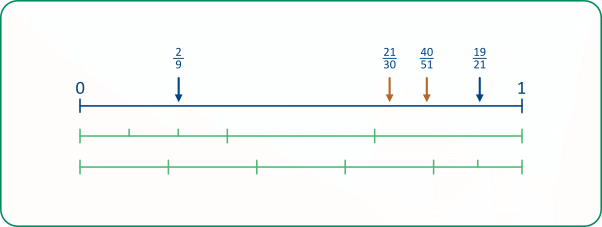In this set of tasks we partition a square (or rectangle or parallelogram) systematically into smaller regions and express the areas of these regions as fractions of the area of the square. In a given task, the areas can be determined geometrically in a variety of ways; we can also use fractions to describe or determine areas, again in a variety of ways. So the tasks can provide pupils with plenty of experience of relating fractions to geometric shapes and of operating with fractions and comparing various fraction expressions and seeing their equivalence.
TASK 24A: There are many ways of solving this task. A simply approach would be to calculate the area of each region, using area formulae: The triangles can be thought of as having a base of 1 unit and a height of ⅔ unit, so they each have an area of ½×1×⅔ = ⅓ unit squares; similarly, we can think of the parallelogram as having a (vertical) base of ⅓ and a height of 1, so its area is 1×⅓ = ⅓. An interesting variant of this would be to find the area of the parallelogram and then deduce the areas of the triangles (if the parallelogram covers ⅓ of the square, then the two identical triangles must cover ⅔ of the square altogether, so ⅓ each). Or we could find the area of the triangles (each covers ⅓ of the square) and deduce that the remaining shape must therefore also cover 1 – ⅔ = ⅓.
In (A), one of the triangles is transformed into a rectangle which clearly (!?) covers ⅓ of the square (so the other triangle also covers ⅓ and so the third region does too). We can also interpret the second diagram in (A) as showing how the parallelogram can be transformed into a rectangle using a shear.
In (B) the upper triangle is translated to join the other triangle, thereby forming a rectangle covering ⅔ of the square. So the remaining shape, which must have the same area as the original parallelogram, covers 1 – ⅔ = ⅓.
In (C-top) we have split each region into two triangles, with each triangle having the same area (½×⅓×1 = ⅙) OR (C-bottom) into 4 congruent triangles.
In (D) the given regions have been transformed into 3 identical parallelograms.
TASK 24B: This time the square is split into 7 regions, all with the same area. Notice that we again have 2 identical triangles, but this time there are 5 parallelograms, rather than 1. Can pupils see how this method of partitioning could be generalised to produce any number of regions with the same area?
The small, top-left triangle covers ⅛ of the square. We can visualise this by, for example, cutting the square into 4 congruent squares and halving one of them (see diagram below, left); or we could use the triangle area formula: ½×½×½ = ⅛. So the green region covers 1 – ½ – ⅛ = ⅜ of the square.
Or we could continue with a visual approach and argue that three such small triangles cover the green region, so it covers ⅛+⅛+⅛ = ⅜ of the square (see diagram below, middle).
We could also cut the green region into two triangles, each with a base of ½ and a height of 1 or of ½, so with a total area of ½×½×1 + ½×½×½ = ¼ + ⅛ = ⅜ (see diagram below, right).
TASK 24D: This again lends itself to a variety of approaches, both geometric and numerical.
A neat way to solve this is to partition the diagram into pairs of congruent white and green triangles, as below. This shows that the green region covers half the square.Of course there are other, perhaps less neat, ways. For example, we could calculate the areas of the white triangular regions and subtract the total from 1:
area of white triangles = ½×1×⅓ + ½×1×⅔ = ⅙ + ⅓ = ½; so area of green region = 1 – ½ = ½.
Or we could partition the green region into a triangle and a parallelogram, giving a total area of
½×⅔×1 + ⅓ = ½.
TASK 24E: This is a variant on the previous task. We can again cut the green region horizontally to produce two triangles congruent to the white triangles. Or we could, for example, find the areas of the white triangles (giving us ⅟₇ + ⁵⁄₁₄ = ⁷⁄₁₄ = ½) and subtract this from 1.
A + B + C = ⅕ + ⅕ + ⅟₁₀ = ⁵⁄₁₀ = ½.
A more direct approach would be to use the formula for the area of a trapezium: The green region is a trapezium with a (horizontal) height of 1 and with parallel sides of length ⅖ and ⅗, whose mean is ½, giving ½×1 = ½.
An interesting way to vary the task is to slide the vertical parallel sides along the edges of the square, as in the ways below. We know that the desired fraction is still ½, as we haven't changed the dimensions of the trapezium, but can we confirm this using geometric or fraction methods?
The diagram below shows a geometric solution, where we think of the square as partitioned into parallelograms congruent to the green region. Altogether there are six, so the green region covers ⅙ of the square.
Here is a more analytic approach:
The equally spaced parallel red lines (below) cut the brown line into 3 equal parts.
So we can think of the green region as two triangles with a combined (horizontal) height of ⅔ and sharing a (vertical) base of ½. So their total area is ½×½×⅔ = ⅙.
TASK 24H: This is essentially the same as the previous task. We have changed the outer square into a parallelogram by means of a shear or stretch, or both. Parallel lines remain parallel, midpoints remain midpoints. We could have done the same to all the earlier tasks.





























